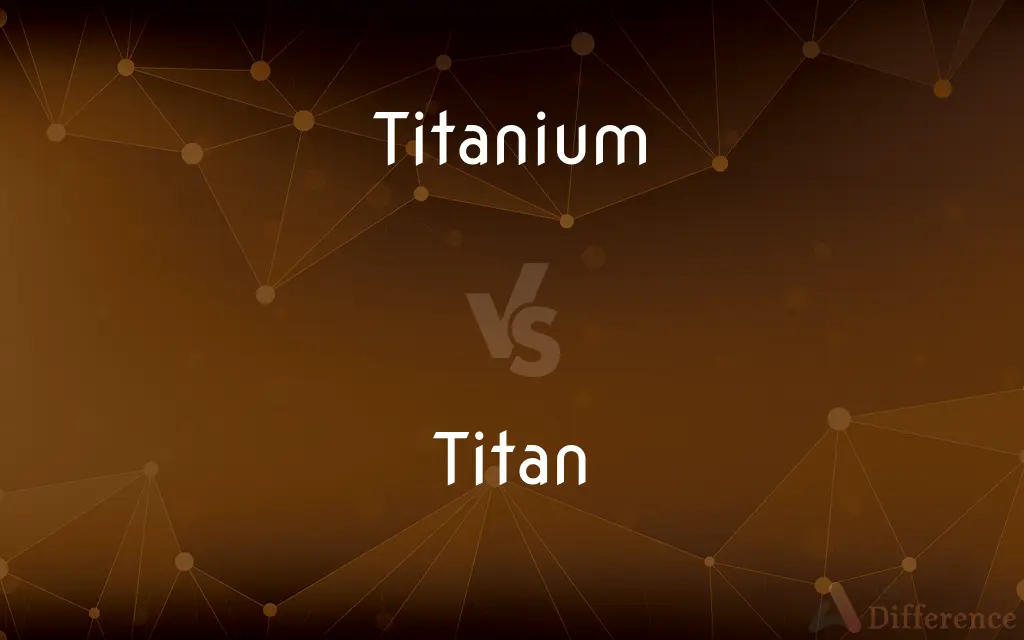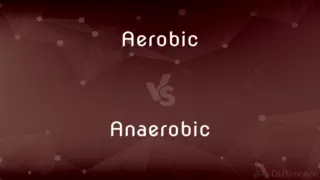Titanium vs. Titan — What's the Difference?
By Maham Liaqat & Urooj Arif — Updated on March 7, 2024
Titanium is a strong, lightweight, corrosion-resistant metal used in various industries, while Titan refers to both mythological giants in Greek mythology and one of Saturn's moons, known for its dense atmosphere and liquid methane lakes.

Difference Between Titanium and Titan
Table of Contents
ADVERTISEMENT
Key Differences
Titanium is a chemical element with the symbol Ti and atomic number 22, renowned for its strength, low density, and resistance to corrosion. This metal finds applications in aerospace, medical devices, and everyday items like watches and bicycles, thanks to its unique properties. Titan, on the other hand, can refer to the Titans of Greek mythology, a race of powerful deities that preceded the Olympian gods, or to Saturn's largest moon, which is of great interest to scientists due to its thick atmosphere and the presence of liquid methane and ethane on its surface.
The production and processing of titanium metal involve extracting it from its ores, such as ilmenite and rutile, and refining it through the Kroll process, making it a high-value material. In contrast, the study of Titan, the moon, involves sophisticated space missions and telescopes to gather data about its climate, geological features, and potential for hosting life, emphasizing the scientific and exploratory effort rather than industrial processes.
Titanium's role in technology and industry highlights human innovation in materials science, creating durable, lightweight, and corrosion-resistant products. The exploration of Titan showcases humanity's quest for knowledge, understanding the solar system, and the possibility of life beyond Earth. Both reflect different facets of human achievement: one in mastering materials for our use and the other in expanding our understanding of the universe.
The value of titanium lies in its physical properties and applications, impacting various sectors by providing solutions to engineering challenges. The significance of Titan, especially in mythology, lies in its cultural and historical impact, shaping ancient Greek narratives about the origins of the cosmos and the gods. As Saturn's moon, Titan's value is in its scientific interest, holding clues about the solar system's history and the potential for life in environments vastly different from Earth's.
Titanium's impact is tangible, seen in the objects and structures it helps create, enhancing our quality of life and pushing the boundaries of engineering and medical science. The impact of Titan, from a mythological and astronomical perspective, is more intangible, fueling our imagination, contributing to our cultural heritage, and expanding our scientific frontiers. Both titanium and Titan, in their respective realms, embody human curiosity and the pursuit of excellence, whether it's in creating materials that shape our world or exploring the cosmos to understand our place in it.
ADVERTISEMENT
Comparison Chart
Nature
Chemical element (metal).
Mythological figures and a moon of Saturn.
Use/Application
Used in aerospace, medical devices, and consumer products.
Subject of mythological stories and scientific exploration.
Significance
Strength, lightweight, corrosion-resistant.
Cultural history in mythology; atmospheric and geological interest in astronomy.
Method of Study/Production
Extracted from ores and refined through the Kroll process.
Studied through space missions and telescopic observations.
Impact
Enhances technology and quality of life.
Fuels imagination and scientific discovery.
Compare with Definitions
Titanium
Extracted from minerals like ilmenite and rutile.
Titanium is often sourced from the mineral rutile found in beach sands.
Titan
Saturn's largest moon, known for its thick atmosphere.
Titan's atmosphere is denser than Earth's, with clouds and methane rain.
Titanium
A strong, lightweight metal resistant to corrosion, ideal for aerospace.
Titanium alloys are used in aircraft structures for their strength-to-weight ratio.
Titan
Explored by the Cassini-Huygens mission, providing valuable data.
The Huygens probe landed on Titan, sending back images of its surface.
Titanium
Popular in consumer goods for its durability.
Titanium frames make eyeglasses lightweight and strong.
Titan
A subject of interest for astrobiology due to its complex organic chemistry.
Scientists study Titan's lakes of liquid methane for clues about prebiotic chemistry.
Titanium
Used in medical implants due to its biocompatibility.
Titanium screws are used in bone surgery for their compatibility with the human body.
Titan
Titans in Greek mythology were powerful deities overthrown by the Olympian gods.
The Titan Cronus was overthrown by his son Zeus.
Titanium
Essential in sports equipment, enhancing performance.
Titanium golf clubs are prized for their lightweight and strength.
Titan
Features in various works of science fiction as a mysterious and exotic location.
Titan is often depicted as a frontier for human exploration in sci-fi stories.
Titanium
Titanium is a chemical element with the symbol Ti and atomic number 22. Its atomic weight is 47.867 measured in daltons.
Titan
Greek Mythology One of a family of giants, the children of Uranus and Gaea, who sought to rule heaven and were overthrown and supplanted by the family of Zeus.
Titanium
A strong, low-density, highly corrosion-resistant, lustrous white metallic element that occurs widely in igneous rocks and is used to alloy aircraft metals for low weight, strength, and high-temperature stability. Atomic number 22; atomic weight 47.87; melting point 1,668°C; boiling point 3,287°C; specific gravity 4.51; valence 2, 3, 4. See Periodic Table.
Titan
Titan One of prodigious size, strength, or achievement
"the twin titans of the beverage industry" (David Barboza).
Titanium
A chemical element, atomic number 22; it is a strong, corrosion-resistant transition metal, used to make light alloys for aircraft etc.
Titan
The largest satellite of Saturn and the second largest satellite in the solar system.
Titanium
(countable) A single atom of this element.
Titan
Something or someone of very large stature, greatness, or godliness.
Titanium
An elementary substance found combined in the minerals manaccanite, rutile, sphene, etc., and isolated as an infusible iron-gray amorphous powder, having a metallic luster. It burns when heated in the air. Symbol Ti. Atomic weight 48.1.
Titan
Titanic.
The Titan physical difficulties of his enterprise.
Titanium
A light strong gray lustrous corrosion-resistant metallic element used in strong light-weight alloys (as for airplane parts); the main sources are rutile and ilmenite
Titan
A person of exceptional importance and reputation
Titan
(Greek mythology) any of the primordial giant gods who ruled the Earth until overthrown by Zeus; the Titans were offspring of Uranus (Heaven) and Gaea (Earth)
Titan
The largest of the satellites of Saturn; has a hazy nitrogen atmosphere
Common Curiosities
What makes titanium unique among other metals?
Titanium's combination of strength, lightness, and resistance to corrosion makes it unique and valuable for various high-performance applications.
What is titanium used for?
Titanium is used in aerospace, medical implants, consumer goods, and sports equipment due to its strength, lightweight, and corrosion resistance.
Why is Titan, Saturn's moon, significant for scientists?
Titan is significant for its thick atmosphere, presence of liquid methane and ethane, and potential for studying prebiotic chemistry and astrobiology.
Who were the Titans in Greek mythology?
The Titans were a race of powerful deities who ruled during the Golden Age and were overthrown by the Olympian gods.
How have missions to Titan expanded our understanding of the solar system?
Missions to Titan, like the Cassini-Huygens mission, have provided insights into its climate, surface, and potential for harboring life, expanding our understanding of the diversity and complexity of celestial bodies in our solar system.
What discoveries have been made about Titan's surface and climate?
Discoveries about Titan's surface include the presence of liquid hydrocarbon lakes and rivers, mainly made of methane and ethane, and a climate that features a cycle similar to Earth's water cycle, but with methane. These findings have been made through radar imaging and data collected by the Cassini-Huygens mission.
Can titanium be found on Titan?
While titanium metal is a human-engineered material, Titan's surface and atmosphere contain various organic molecules and elements, but direct evidence of titanium in its metallic form on Titan has not been a focus of study.
What processes are used to refine titanium?
The Kroll process is the primary method used to refine titanium, involving the reduction of titanium tetrachloride with magnesium to produce pure titanium metal.
How do the atmospheres of Earth and Titan compare?
Titan's atmosphere is thick, nitrogen-rich, and contains organic molecules, making it the only moon in the solar system with a dense atmosphere, while Earth's atmosphere is also nitrogen-rich but supports life with its oxygen content and protective layers.
Is there any connection between titanium and Titan?
Beyond the similarity in names, there is no direct connection between titanium, the metal, and Titan, Saturn's moon or the mythological figures. Each stands out in its own field for distinct reasons: titanium for its material properties and applications, and Titan for its cultural and scientific significance.
Why is titanium considered biocompatible?
Titanium is considered biocompatible because it does not react adversely with human tissue, making it ideal for medical implants such as joint replacements and dental implants, as it can integrate with bone without causing harmful reactions.
What role did the Titans play in Greek mythology?
In Greek mythology, the Titans were the children of Uranus (Sky) and Gaia (Earth), who ruled the cosmos before being overthrown by the Olympians, leading to Zeus' rise to power and the establishment of the new pantheon of gods.
Share Your Discovery

Previous Comparison
Drink vs. Sip
Next Comparison
Aerobic vs. AnaerobicAuthor Spotlight
Written by
Maham LiaqatCo-written by
Urooj ArifUrooj is a skilled content writer at Ask Difference, known for her exceptional ability to simplify complex topics into engaging and informative content. With a passion for research and a flair for clear, concise writing, she consistently delivers articles that resonate with our diverse audience.
















































